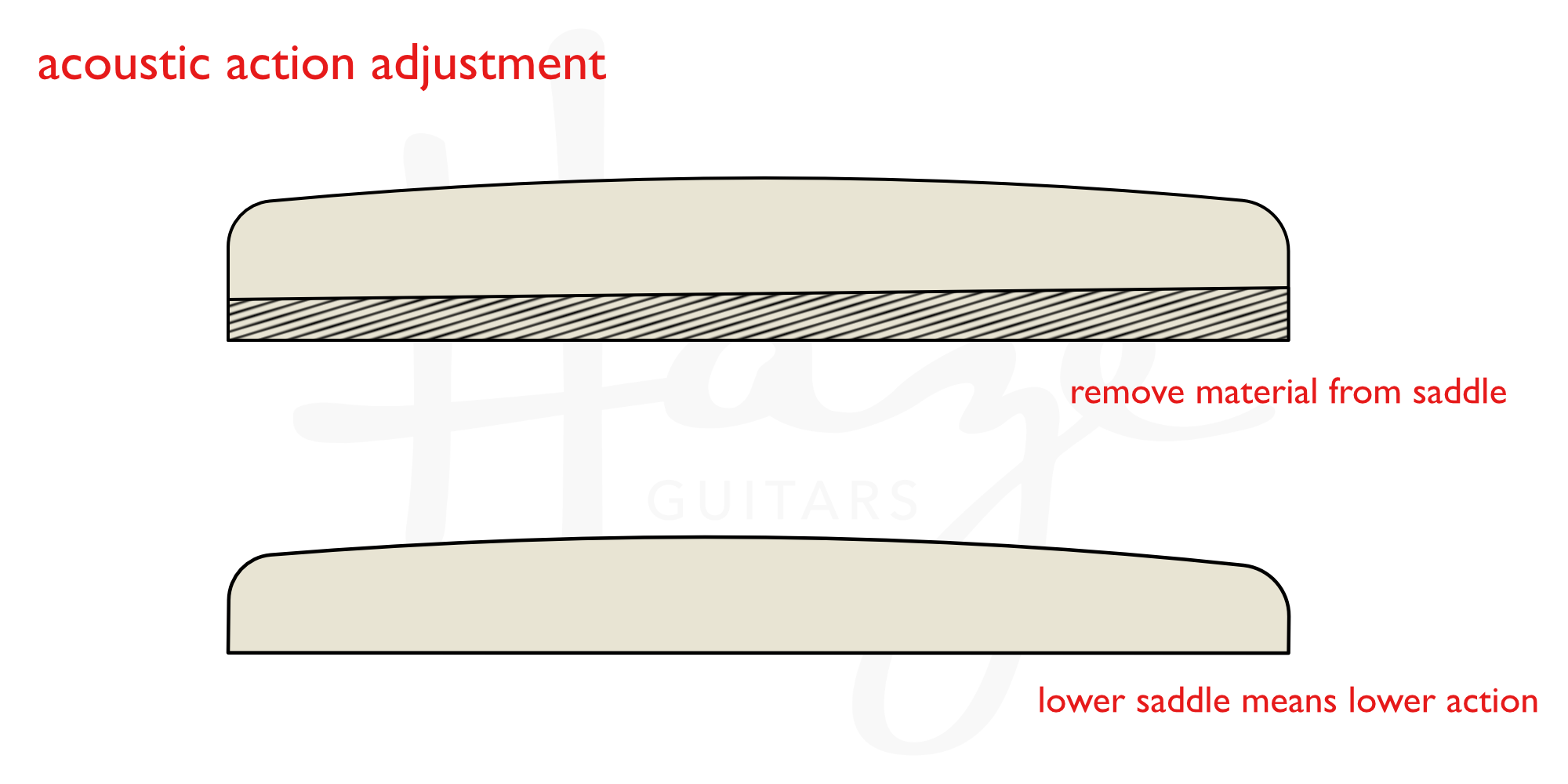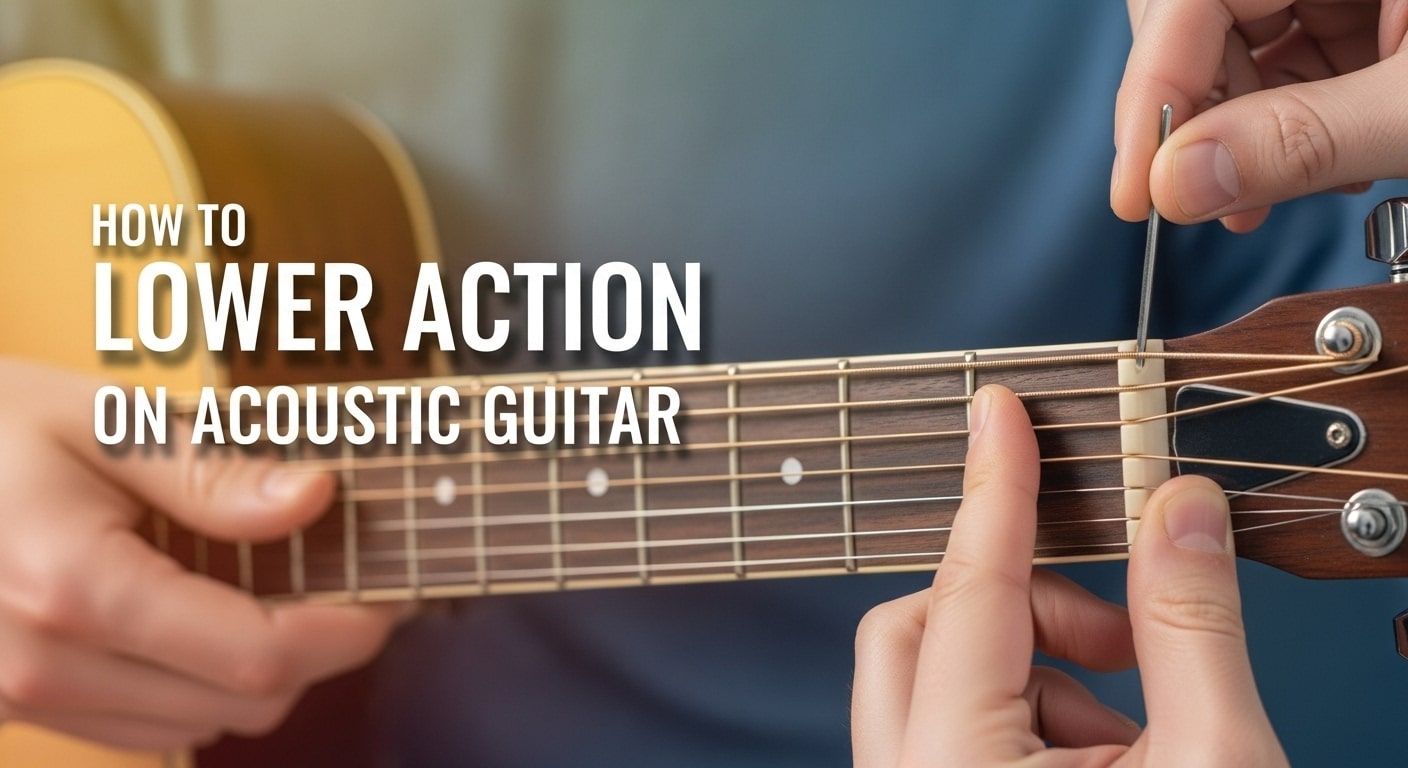Is your acoustic guitar feeling harder to play than it should? High action—the distance between your strings and fretboard—can make chords tough to press and slow down your progress.
But here’s the good news: lowering your guitar’s action can transform your playing experience, making your instrument feel smooth and effortless under your fingers. Whether your strings buzz or your fingers ache, this guide will walk you through simple, effective steps to lower your acoustic guitar’s action.
You don’t need to be a pro or have fancy tools—just a little patience and the right know-how. Ready to make your guitar play the way you want? Let’s dive in and get those strings closer to your fingertips.

Credit: www.wikihow.com
Action Basics
Understanding the basics ofguitar action is key to making your acoustic guitar easier to play. Action refers to the height of the strings above the fretboard. This height affects how hard or easy it is to press the strings down. Lowering the action can improve playability and reduce finger fatigue.
Before adjusting, knowing what action is and how it impacts your playing helps you make the right changes. Small adjustments can make a big difference in your guitar’s feel and sound.
What Is Action
Action is the distance between the strings and the frets on your guitar. It is measured at the 12th fret. High action means the strings sit far from the fretboard. Low action means the strings are close to the frets.
The action height depends on the bridge saddle and the nut slots. It also depends on the neck’s curve or relief. Adjusting these parts changes the action.
Effects Of High Action
High action makes pressing strings harder. This can tire your fingers quickly. It may cause buzzing if the strings are too close or too far in some spots. High action can also affect tuning stability.
Many beginners struggle with high action because it requires more finger strength. Lowering the action helps play faster and more comfortably. It also improves sound clarity and reduces finger pain.
Measuring Action
Measuring the action on an acoustic guitar is the first step to lowering it properly. Action refers to the height of the strings above the fretboard. Accurate measurement helps identify what adjustments are needed. Small changes can make a big difference in playability and tone.
Checking String Height
Use a ruler or action gauge to measure string height. Measure at the 12th fret, where the string should be closest to the fretboard. Typical action height is around 2.5mm for the high E string and 3mm for the low E string. Higher measurements mean the action is too high. Lower action makes the guitar easier to play but too low can cause buzzing.
Assessing Neck Relief
Neck relief is the slight curve in the guitar neck. Check it by pressing a string at the first fret and the fret where the neck meets the body. Then look at the gap between the string and frets around the 7th fret. A small gap means the neck has the right amount of relief. Too much curve raises the action. Too little can cause buzzing. Adjusting the truss rod controls neck relief.
Truss Rod Adjustments
The truss rod inside your acoustic guitar’s neck helps control its curvature. Adjusting it can change the neck’s relief and affect the string height, also called the action. A proper truss rod adjustment can lower the action and make your guitar easier to play. This process requires care and the right tools to avoid damage.
Tools Needed
You will need a truss rod wrench that fits your guitar’s nut. Most guitars use an Allen wrench or a special spanner. Have a capo and a ruler or feeler gauge for measuring the relief. A soft cloth helps protect your guitar during the adjustment.
Turning The Truss Rod
Turning the truss rod nut clockwise tightens it and straightens the neck. This reduces the forward bow and lowers the action. Turning it counterclockwise loosens the rod and adds relief, raising the action. Make very small turns, about a quarter turn or less at a time.
Step-by-step Adjustment
- Place a capo on the first fret to hold the strings down.
- Press the last fret on the neck and measure the gap at the 7th or 8th fret.
- Use the truss rod wrench to turn the nut clockwise if the gap is too large.
- Wait a few minutes for the neck to settle after each turn.
- Re-measure the relief and repeat until the gap is small but not zero.
- Remove the capo and check the overall string height and playability.
Precautions And Tips
Always turn the truss rod nut slowly and gently. Avoid forcing it, as it can break the rod or damage the neck. Make small adjustments and allow time for the wood to adjust. If unsure, ask a professional for help. Proper adjustment improves playability without harming your guitar.

Credit: hazeguitars.com
Saddle Modifications
The saddle plays a key role in the string height on an acoustic guitar. Adjusting it can lower the action, making the guitar easier to play. This process involves removing the saddle, filing it down carefully, then reinstalling it to test the new height. Proper saddle modification improves playability without harming the guitar’s tone or structure.
Removing The Saddle
Start by loosening and removing the strings to access the saddle. Gently pull the saddle straight up from the bridge slot. Use a thin, flat tool if it is tight, but avoid forcing it. Keep the saddle clean and handle it carefully to prevent damage.
Filing The Saddle
Place the saddle on a flat surface before filing. Use fine-grit sandpaper or a small file to remove material from the bottom of the saddle. File evenly to keep the saddle level. Remove only a small amount at a time to avoid lowering the action too much. Check the thickness frequently during the process.
Reinstalling And Testing
Put the saddle back into the bridge slot carefully. Tune the guitar to pitch and check the string height. Play each string to feel the new action and listen for any buzzing. Repeat filing if further lowering is needed. Always make small adjustments to maintain good playability and tone.
Nut Slot Adjustments
The nut plays a key role in setting your guitar’s string height at the first fret. Adjusting the nut slots can help lower the action near the nut area. This change makes playing easier and reduces finger strain. Careful nut slot adjustments improve playability without harming the guitar’s tone or setup.
Nut slot adjustments require precision and care. Small changes can have a big impact on string height. Understanding how to identify and file the nut slots safely is important for a smooth setup. Below are detailed steps to guide you through the process.
Identifying High Nut Slots
Check string height at the first fret with a feeler gauge or ruler. If strings sit too high above the fret, the nut slots may be too shallow. High nut slots cause buzzing or difficulty pressing strings down. Play each string slowly and listen for muted or sharp sounds. This test helps find which slots need adjustment.
Filing Nut Slots Safely
Use a set of nut files designed for guitar maintenance. Select a file that matches the string gauge. File gently and evenly, removing tiny amounts at a time. Keep the file angle matching the string’s natural path to the tuning peg. Test string height frequently to avoid over-filing. Polish the slots after filing to prevent string binding and improve tuning stability.
Additional Tips
Lowering the action on your acoustic guitar can greatly improve playability and comfort. Along with adjusting the saddle and truss rod, some extra care tips help keep your guitar in perfect shape. These additional tips focus on environmental factors and knowing when to ask a professional. Proper maintenance ensures your guitar stays easy to play over time.
Humidity And Temperature Effects
Wood in guitars reacts to humidity and temperature changes. High humidity makes the wood swell, raising the action. Low humidity causes the wood to shrink, sometimes lowering the action too much. Keep your guitar in a stable environment. Use a humidifier or dehumidifier if needed. Avoid sudden temperature shifts, like leaving the guitar in a hot car. These steps help maintain consistent action and prevent damage.
When To Seek Professional Help
Some adjustments require skill and special tools. If the action stays high after basic tweaks, visit a guitar technician. Professionals can fix warped necks, uneven frets, or badly cut nut slots. They have the right tools to file the saddle or nut safely. Trying complex fixes without experience can damage your guitar. A technician ensures your guitar plays well and stays healthy for years.

Credit: www.wikihow.com
Frequently Asked Questions
How Do I Lower The Action On My Acoustic Guitar?
Lower acoustic guitar action by tightening the truss rod clockwise to reduce neck relief. File the bridge saddle bottom slightly. Lower nut slots if needed. Make small adjustments and check frequently to avoid damage.
Why Is The Action On My Acoustic Guitar So High?
High action on your acoustic guitar often results from neck bowing, high saddle or nut, or changes in humidity. Adjusting the truss rod, lowering the saddle, or filing nut slots can help reduce string height and improve playability.
Which Way Do I Turn The Truss Rod To Lower Action?
Turn the truss rod clockwise (to the right) to tighten it and lower the guitar’s action by reducing neck relief. Make small adjustments and check frequently.
Can I Adjust Guitar Action Myself?
Yes, you can adjust guitar action yourself by tightening the truss rod and lowering the saddle or nut slots carefully. Use proper tools and make small adjustments to avoid damage.
Conclusion
Lowering the action on your acoustic guitar improves playability and comfort. Small, careful adjustments make a big difference. Always check the neck relief before changing string height. Use the right tools and take your time with each step. Regular maintenance keeps your guitar sounding and feeling great.
A well-set action helps you enjoy playing more every day.

Senior Music Reviewer
Alex Carter is a seasoned music reviewer with over a decade of experience in the world of sound and instruments. Passionate about helping musicians and enthusiasts make informed choices, he brings sharp insights and in-depth knowledge to every review. From classical instruments to modern gear, Alex combines technical expertise with a love for music to deliver content that resonates with readers.
As a Senior Music Reviewer and expert author on Tuneluma.com, Alex is dedicated to sharing honest evaluations, practical advice, and thoughtful commentary to guide readers in their musical journey.


Leave a Reply